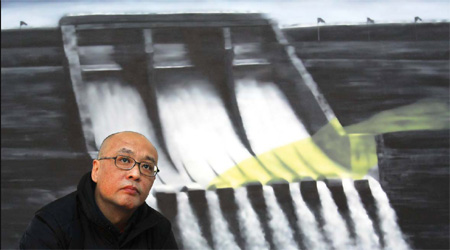-
-
MSNBC Marquee
Rihanna’s dad cut out of her life ‘over nothing’
Rihanna and her father both spoke to the press about their most recent estrangement.
Theater & Arts
On the record
By Zhu Linyong (China Daily)
Updated: 2009-11-23 11:42
 |
|
"I have to face reality," says Chinese painter Zhang Xiaogang, seen here with his oil-on-linen work Dam at his solo exhibiton The Records in Beijing. |
Artist Zhang Xiaogang says he's "a person who lives in the past".
"I hate to face reality and feel more comfortable indulging in a remembered dream," says the 51-year-old, widely considered one of the most outstanding figures in China's contemporary art scene.
"For me, it is horrible to live completely in reality, or in a dream. Rather, I prefer living in a mental state of half-dreaming and half-awake," says Zhang whose works have sold for astronomical prices at auctions worldwide over the past few years.
Memory is a recurring motif in his art.
"I do not depict reality directly in my works. Nor would I position myself as a vanguard artist. What I am doing is just expressing myself truthfully," Zhang says, talking about his latest solo exhibition, The Records.
Themed "having a memory and the loss of memory", the exhibition presented over 70 of his works done over the past two years, ranging from oil paintings, bronze and cement sculptures, installations, to prints and paintings done on stainless steel plates.
The sculptures are reminiscent of the early years of China's opening up and reform, featuring light bulbs, thermos flasks, inkbottles, bicycles, cassette tapes, and small chairs usually seen in primary schools in rural China.
"Chinese society is transforming too fast. What is reality today becomes history tomorrow and that is why we call the exhibition The Records."
Originally, Records of the Great Historian (), was an ancient script by Sima Qian (135-86 BC) on the history of China, from the Yellow Emperor to emperor Han Wudi (156-87 BC).
For the stainless plate paintings, Zhang did impromptu "diary-writing" in his spacious studio at Hegezhuang, on the eastern outskirts of Beijing.
"I wrote what come to mind on the stainless plates, a memory of a party the day before, or a piece of news I overheard on TV that morning, or just fragments of fleeting ideas at that moment," Zhang says.
But it was one item from his "false diaries" that gained the most attention from both critics and viewers. It read: "My life is just like canned food. It is deeply influenced by three things - Capitalism, Communism and traditional Chinese values."
Critics say Zhang's art reflects the collective memory of Chinese people over the past half century.
 |
|
Amnesia and Memory, oil-on-linen by Zhang Xiaogang. |
"Different lifestyles, life experiences and surroundings leave different impressions in a person's heart," explains Zhang.
"My works reflect my childhood and teenage memories. During the time when I grew up, China was a completely different place from now."
The third of four boys, Zhang was born in 1958 to an official's family in Kunming, Yunnan province. They later settled in Chengdu, Sichuan province.
Although he began drawing at 4 under the guidance of his mother, Zhang did not take art seriously until he was 16 when Lin Ling (1918-2007), a self-made artist, instilled basic ideas and techniques in him.
"I could not control my desire to paint. I visited my teacher almost every day," recalls Zhang.
"With hard work, I made remarkable progress in a short period of time. But my parents feared that I might go crazy."
Zhang's early artistic progress, however was interrupted by the "cultural revolution" (1966-76). As a primary school boy, he was terrified by the experiences of his family during those years.
His parents were interrogated and went through years of hardships. "People often rushed to our house and asked my parents what they did wrong," Zhang says.
In the mid 1970s, like so many youths, Zhang went to work in the countryside as a zhiqing, or intellectual youth. But even then, Zhang did not give up his dream of becoming an artist.
When the "cultural revolution" came to an end, Zhang decided to try his luck at an art academy and applied for the newly reinstated college entrance examination in 1978.
After graduating from the Sichuan Academy of Fine Arts in the 1980s, Zhang became a leader of the so-called "Sichuan school" of painters, producing surrealistic, folkloric and psychologically inspired paintings, an important force in the 1985 avant-garde movement.
Later, after his visit to art exhibitions and museums in Europe in 1990, he developed a more subtle and colorful style, painting what he calls "false portraits", inspired by old photos at his parent's home.
These paintings explored the tension between public and private lives.
Among all his works, Bloodline: The Big Family series, which he has been developing since 1993, is arguably the most famous.
In these large, oil-on-linen paintings, the subjects usually pose against a neutral, mottled backdrop, facing the viewer, stiff and emotionless, as if captured in a passport photo.
And in many of these works, Zhang often depicts a young couple next to their baby. From the baby, a fine red line can always be seen tracing back to the parents.
Zhang says these indicate bloodlines linking all Chinese to one family.
Zhang often swaps gender characteristics to make men and women seem neutral or identical and says this indicates, among other things, a uniformity imposed by contemporary Chinese society.
In his portraits, the eyes of people, especially children, are mildly exaggerated and have a glassy, android quality. The surface is vaguely tinted, so that the images appear as if seen in a dream.
Meanwhile, a small, translucent colored patch appears over every delicately painted face, like a random pool of light.
Zhang says these elements carry layers of meanings - a sort of DNA marker, showing each person's hidden individuality, or a certain kind of personal memory.
Zhang admits he is deeply influenced by Western artists such as Salvador Dali and Pablo Picasso, but adamantly denies he is a follower of Western Surrealism or Symbolism.
"Yes, we have learned from the West over the years. But Chinese contemporary art has formed its unique character, deeply rooted in Chinese history and culture," Zhang explains.
"Fast changing social reality has also lent Chinese artists inexhaustible resources and inspiration for artistic creation."
Over the past years, Zhang's works have been popular in the art market.
In 2007, one of his paintings sold at auction for $3.8 million, one of the highest prices paid for a work by a living Chinese artist.
In 2008, his works, sold at international auctions, registered a total of 301 million yuan ($44 million), the highest transaction volume for a living Chinese artist.
"All these phenomena have nothing to do with myself, I have no control at all of those works I sold many years ago," Zhang says.
"No artist can predict whether he will be hot or not in the art market. For me, it's just luck."
Zhang admits that during his early professional life, things weren't easy, just like many of today's young artists who are struggling for recognition.
There was a prolonged period of time in the mid-1980s when he struggled with depression and alcoholism.
Fortunately, Zhang says years of hardship have enabled him to see fortune and prestige calmly.
"An artist should not pay too much attention to the prices. Instead, he should put all his heart into creating the best work he can."
He paints a rosy picture for Chinese contemporary art.
"Despite a currently lackluster art market, I am confident that contemporary Chinese art has a great future. Simply put, it is just beginning."
The Records ended on Friday at the 798 Art Zone in Beijing.






